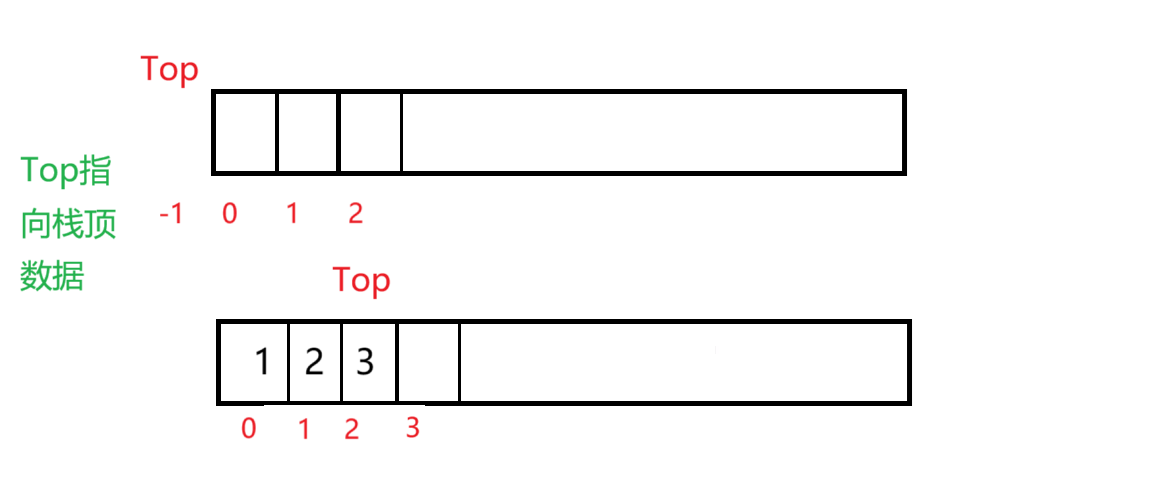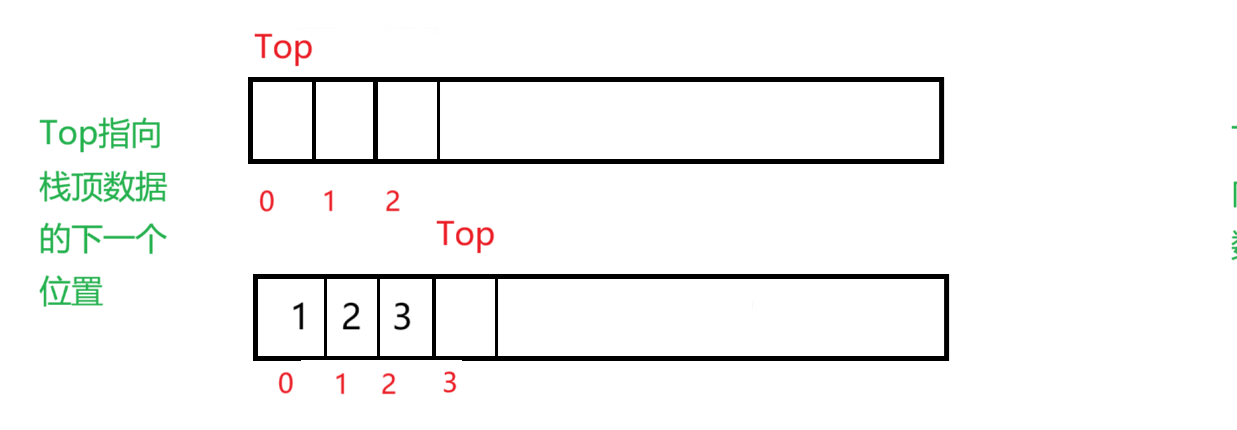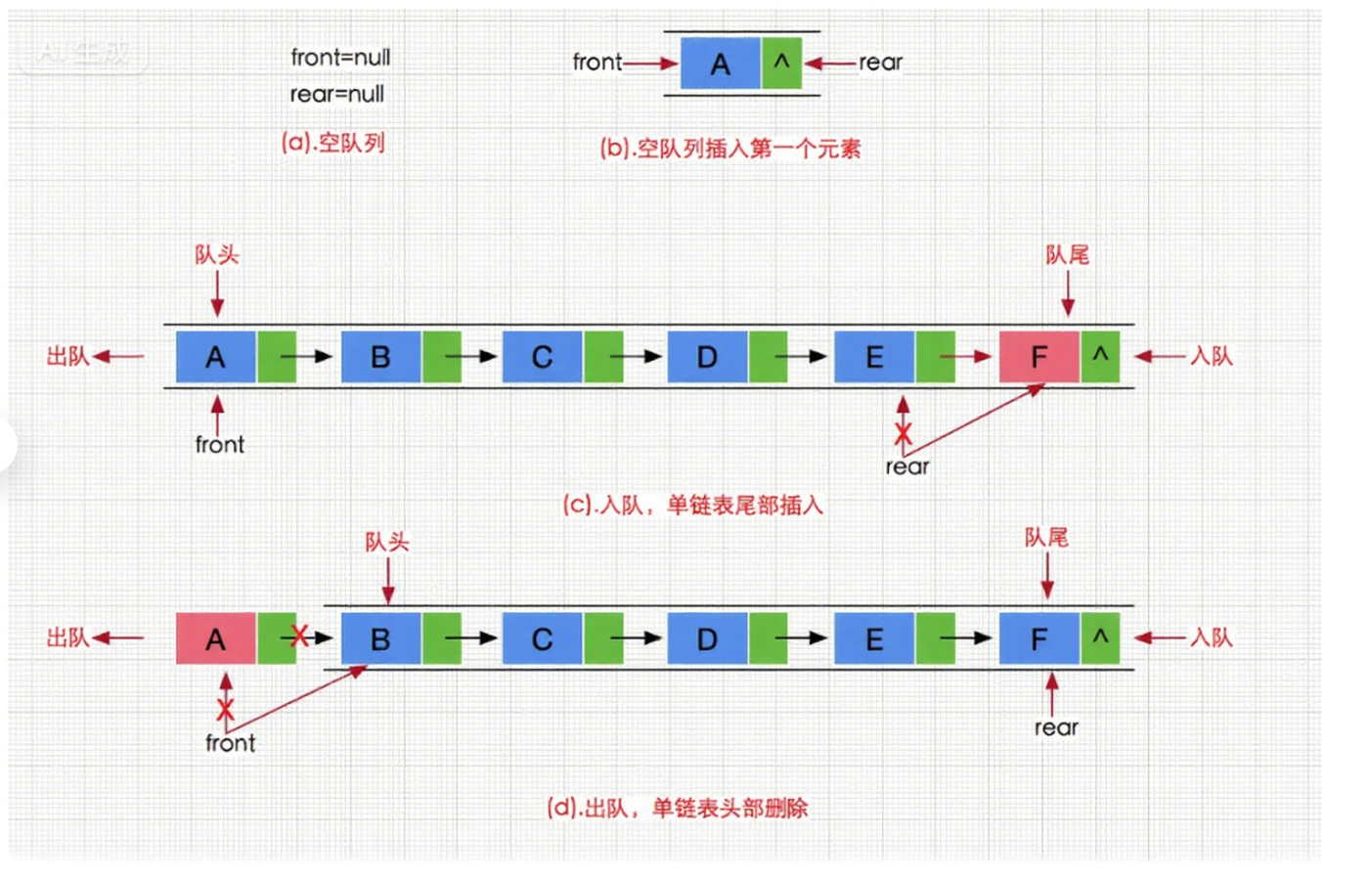文章目录
[1.3、 栈的实现](#1.3、 栈的实现)
[7、 获取队尾数据](#7、 获取队尾数据)
前言
栈和队列是计算机科学中两种重要的线性数据结构,均用于存储和管理数据元素。但它们的操作规则和应用场景不同,栈遵循"先进后出"的原则,而队列遵循"先进先出"的原则。
1、栈(Stack)
1.1、栈的概念和结构
栈是一种特殊的线性表,其只允许在固定的一端进行插入和删除元素操作。栈中的数据元素遵守后进先出LIFO(Last In First Out)的原则。
**- 栈顶:**进行数据的插入和删除的一端;
**- 栈底:**不允许操作的一端;
基本操作:
**- 入栈/压栈(Push):**在栈顶添加元素;
**- 出栈(Pop):**从栈顶移除并返回元素;
**- 查看栈顶元素(Peek):**返回栈顶元素但不删除;
**- 判空(IsEmpty):**检查栈中元素是否为空;
**- 获取栈的大小(Size):**栈中元素个数。

压栈和出栈如下图

1.2、栈的实现方式及解析
栈最重要的就是其先进后出的原则,要实现栈,就要选择能够满足这种原则的方法。
我们发现,其实数组(顺序表),单链表和双向链表都能够用来实现栈。对于数组,压栈可以用realloc来动态扩容,出栈可以直接利用数组的下标;对于单链表,压栈可以用malloc动态申请空间并尾插,出栈只需要找到尾节点然后释放即可;对于双向链表,与单链表相同,只是双向链表可以通过头节点快速找到尾节点。双向链表由于prev指针,所以有额外的空间消费,只是找尾比较方便;相比于单链表,数组在压栈和出栈时,下标就很有优势,代价较小。所以我们选择用数组实现栈。
|-------|-----------------|------------------|
| 特性 | 数组 | 单链表 |
| 存储空间 | 连续的空间 | 不一定连续 |
| 随机访问 | O(1) | O(N) |
| 压栈 | realloc扩容(成本较高) | malloc动态申请(成本较低) |
| 应用场景 | 元素高效存储+频繁访问 | 任意位置插入和删除频繁 |
| 缓存利用率 | 高 | 低 |
栈主要是对尾部数据进行删除和插入操作,而数组在尾部操作的时间复杂度为O(1),同时,我们可以用二倍扩容来进一步降低扩容成本。
1.3、 栈的实现
我们用多个文件的方式实现,下面先展示头文件,因为头文件包含定义顺序表结构,和实现函数的声明,方便我们的理解。
Stack.h
#include<stdio.h>
#include<stdlib.h>
#include<assert.h>
#include<stdbool.h>
//以顺序表的方式实现栈
typedef int DateType;
//定义顺序表的结构
typedef struct Stack
{
DateType* arr; //不定长数组
int top; //栈顶位置
int capacity; //容量
}ST;
//初始化
void STInit(ST* pst);
//销毁
void STDestry(ST* pst);
//压栈
void STPush(ST* pst,DateType x);
//出栈
void STPop(ST* pst);
//取栈顶数据
DateType STTop(ST* pst);
//获取数据个数
int STSize(ST* pst);
//判空
bool STEmpty(ST* pst);1、初始化
初始化时,要特别注意对Top的定义,主要有两种情况:
Top指向栈顶数据,此时,Top应该初始化为-1;

Top指向栈顶数据的下一个位置,此时,Top应该初始化为0;

这里,我们定义Top指向栈顶数据的下一个位置。
//初始化
void STInit(ST* pst)
{
assert(pst);
pst->arr = NULL;
//如果想让栈顶就是最后一个数据,则pst->top应该初始化为 -1 。
pst->top = 0;
pst->capacity = 0;
}2、销毁
//销毁
void STDestry(ST* pst)
{
assert(pst);
free(pst->arr);
pst->arr = NULL;
pst->top = pst->capacity = 0;
}3、压栈
与前面顺序表尾插的思路一致。
//插入数据
void STPush(ST* pst, DateType x)
{
assert(pst);
//处理空间不足的情况
if (pst->top == pst->capacity)
{
//三目操作符处理pst->top为0的情况
int newcapacity = pst->top == 0 ? 4 : 2 * pst->capacity;
DateType * tmp = realloc(pst->arr, sizeof(DateType) * newcapacity);
if (tmp == NULL)
{
perror("realloc");
exit(1);
}
pst->arr = tmp;
pst->capacity = newcapacity;
}
//插入数据
pst->arr[pst->top] = x;
pst->top++;
//pst->arr[pst->top++] = x;
}4、出栈
//删除数据(出栈)
void STPop(ST* pst)
{
assert(pst);
assert(pst->top > 0);
pst->top--;
}5、取栈顶数据
//取栈顶数据
DateType STTop(ST* pst)
{
assert(pst);
assert(pst->top > 0);
return pst->arr[pst->top-1];
}6、获取栈的大小
//获取数据个数
int STSize(ST* pst)
{
assert(pst);
return pst->top;
}7、判空
当pst->top==0时,返回true,反之返回false。
//判空
bool STEmpty(ST* pst)
{
assert(pst);
return pst->top == 0;
}1.4、栈实现完整源码
Stack.c(实现代码)
#include"Stack.h"
//初始化
void STInit(ST* pst)
{
assert(pst);
pst->arr = NULL;
//pst->top = 0;默认栈顶是在栈的最后一个数据之后,这样也方便插入数据
//如果想让栈顶就是最后一个数据,则pst->top应该初始化为 -1 。
pst->top = 0;
pst->capacity = 0;
}
//销毁
void STDestry(ST* pst)
{
assert(pst);
free(pst->arr);
pst->arr = NULL;
pst->top = pst->capacity = 0;
}
//插入数据
void STPush(ST* pst, DateType x)
{
assert(pst);
//处理空间不足的情况
if (pst->top == pst->capacity)
{
//三目操作符处理pst->top为0的情况
int newcapacity = pst->top == 0 ? 4 : 2 * pst->capacity;
DateType * tmp = realloc(pst->arr, sizeof(DateType) * newcapacity);
if (tmp == NULL)
{
perror("realloc");
exit(1);
}
pst->arr = tmp;
pst->capacity = newcapacity;
}
//插入数据
pst->arr[pst->top] = x;
pst->top++;
//pst->arr[pst->top++] = x;
}
//删除数据(出栈)
void STPop(ST* pst)
{
assert(pst);
assert(pst->top > 0);
pst->top--;
}
//取栈顶数据
DateType STTop(ST* pst)
{
assert(pst);
assert(pst->top > 0);
return pst->arr[pst->top-1];
}
//获取数据个数
int STSize(ST* pst)
{
assert(pst);
return pst->top;
}
//判空
bool STEmpty(ST* pst)
{
assert(pst);
return pst->top == 0;
}test.c(测试代码)
#include"Stack.h"
int main()
{
ST s;
STInit(&s);//初始化
//插入数据
STPush(&s, 1);
STPush(&s, 2);
STPush(&s, 3);
STPush(&s, 4);
//获取数据个数
int num = STSize(&s);
printf("%d\n", num);
//出栈
STPop(&s);
STPop(&s);
//STPop(&s);
//STPop(&s);
int temp = s.top;
while (temp)//打印
{
printf("%d->", s.arr[--temp]);
}
//取栈顶数据
DateType ret = STTop(&s);
printf("\n%d\n", ret);
int x = STSize(&s);
printf("%d\n", x);
return 0;
}2、队列(Queue)
2.1、队列的概念和结构
队列是只允许在一端进行插入数据操作,在另一端进行删除数据操作的特殊线性表,队列具有先进先出 FIFO(First In First Out) 原则。进行插入操作的一端称为队尾(入队列 );进行删除操作的一端称为队头(出队列)。

- 基本操作:
- 入队(Enqueue):在队尾添加元素。
- 出队(Dequeue):从队头移除并返回元素。
- 查看队头元素(Front):返回队头元素但不删除。
- 判断队列是否为空(IsEmpty):检查队列中是否没有元素。
- 获取队列的大小(Size):返回队列中元素的数量。
2.2、队列的实现方式解析
队列的操作原则是先进先出,也可以数组和链表的结构实现。使用链表的结构实现时,尾插和头删即对应入队列和出队列;如果使用数组的结构,出队列在数组头上出数据,需要整体往前移动数组的元素,效率会比较低。所以单链表结构更优

2.3、队列的实现
我们用多个文件的方式实现,部分实现方法与单链表的实现基本一致。下面先展示头文件,因为头文件包含定义队列节点结构,和实现函数的声明,方便我们的理解。
Queue.h
#include<stdio.h>
#include<stdlib.h>
#include<assert.h>
#include<stdbool.h>
typedef int Datetype;
//单链表实现队列
//定义队列节点结构
typedef struct QueueNode
{
Datetype val;
struct QueueNode* next;
}QNode;
//由于队列是先进先出,即在出队列时需要找到队头,插入时需要找到队尾。因此,我们用两个指针来记录队头与队尾
//同时,用size来记录队列的数据个数
typedef struct Queue
{
QNode* phead;//指向队头
QNode* ptail;//指向队尾
int size; //有效数据个数
}Queue;
//队列初始化
void QueueInit(Queue* pst);
//队列销毁
void QueueDestry(Queue* pst);
//队尾插入
void QueuePush(Queue* pst, Datetype x);
//队头删除
void QueuePop(Queue* pst);
//获取队列大小
int QueueSize(Queue* pst);
//获取队头数据
Datetype QueueFront(Queue* pst);
//获取队尾数据
Datetype QueueBack(Queue* pst);
//判空
bool QueueEmpty(Queue* pst);1、队列初始化
//队列初始化
void QueueInit(Queue* pst)
{
assert(pst);
pst->phead = NULL;
pst->ptail = NULL;
pst->size = 0;
}2、队列销毁
//队列销毁
void QueueDestry(Queue* pst)
{
assert(pst);
QNode* cur = pst->phead;
while (cur)
{
QNode *next= cur->next;
free(cur);
cur = next;
}
pst->phead = pst->ptail = NULL;
pst->size = 0;
}3、队尾插入(入队列)
//队尾插入
void QueuePush(Queue* pst, Datetype x)
{
assert(pst);
QNode* newnode = (QNode*)malloc(sizeof(QNode));
if (newnode == NULL)
{
perror("malloc");
exit(1);
}
newnode->val = x;
newnode->next = NULL;
if (pst->phead == NULL)
{
pst->phead = pst->ptail = newnode;
}
else
{
pst->ptail->next = newnode;
pst->ptail = newnode;
}
pst->size++;
}4、队头删除(出队列)
//队头删除
void QueuePop(Queue* pst)
{
assert(pst&&pst->ptail);
//一个节点
if (pst->phead->next == NULL)
{
free(pst->phead);
pst->phead = pst->ptail = NULL;
}
//多个节点
else
{
QNode* next = pst->phead->next;
free(pst->phead);
pst->phead = next;
}
pst->size--;
}5、获取队列大小
//获取队列大小
int QueueSize(Queue* pst)
{
assert(pst);
return pst->size;
}6、获取队头数据
//获取队头数据
Datetype QueueFront(Queue* pst)
{
assert(pst);
assert(pst->phead);
return pst->phead->val;
}7、 获取队尾数据
//获取队尾数据
Datetype QueueBack(Queue* pst)
{
assert(pst);
assert(pst->ptail);
return pst->ptail->val;
}8、判空
//判空
bool QueueEmpty(Queue* pst)
{
assert(pst);
return pst->ptail == NULL;
//return pst->size==0;
}2.4、队列实现完整源码
Queue.c(实现代码)
#include"Queue.h"
//队列初始化
void QueueInit(Queue* pst)
{
assert(pst);
pst->phead = NULL;
pst->ptail = NULL;
pst->size = 0;
}
//队列销毁
void QueueDestry(Queue* pst)
{
assert(pst);
QNode* cur = pst->phead;
while (cur)
{
QNode *next= cur->next;
free(cur);
cur = next;
}
pst->phead = pst->ptail = NULL;
pst->size = 0;
}
//队尾插入
void QueuePush(Queue* pst, Datetype x)
{
assert(pst);
QNode* newnode = (QNode*)malloc(sizeof(QNode));
if (newnode == NULL)
{
perror("malloc");
exit(1);
}
newnode->val = x;
newnode->next = NULL;
if (pst->phead == NULL)
{
pst->phead = pst->ptail = newnode;
}
else
{
pst->ptail->next = newnode;
pst->ptail = newnode;
}
pst->size++;
}
//队头删除
void QueuePop(Queue* pst)
{
assert(pst&&pst->ptail);
//一个节点
if (pst->phead->next == NULL)
{
free(pst->phead);
pst->phead = pst->ptail = NULL;
}
//多个节点
else
{
QNode* next = pst->phead->next;
free(pst->phead);
pst->phead = next;
}
pst->size--;
}
//获取队列大小
int QueueSize(Queue* pst)
{
assert(pst);
return pst->size;
}
//获取队头数据
Datetype QueueFront(Queue* pst)
{
assert(pst);
assert(pst->phead);
return pst->phead->val;
}
//获取队尾数据
Datetype QueueBack(Queue* pst)
{
assert(pst);
assert(pst->ptail);
return pst->ptail->val;
}
//判空
bool QueueEmpty(Queue* pst)
{
assert(pst);
return pst->ptail == NULL;
//return pst->size==0;
}test.c(测试代码)
#include"Queue.h"
int main()
{
Queue pq;
QueueInit(&pq);//初始化
//队尾插入
QueuePush(&pq, 1);
QueuePush(&pq, 2);
QueuePush(&pq, 3);
QueuePush(&pq, 4);
////队头删除
//QueuePop(&pq);
QNode* ps = pq.phead;
while (ps)
{
printf("%d->", ps->val);
ps = ps->next;
}
////取队列数据个数
//int num = QueueSize(&pq);
//printf("\n%d\n", num);
////获取队头数据
//Datetype Front = QueueFront(&pq);
//printf("\n%d\n", Front);
////获取队尾数据
//Datetype Back = QueueBack(&pq);
//printf("\n%d\n", Back);
////判空
//bool flag = QueueEmpty(&pq);
//if (flag)
// printf("\n空\n");
//else
// printf("\n非空\n");
//销毁
QueueDestry(&pq);
return 0;
}3、栈和队列比较
|------|---------------|---------------|
| 特性 | 栈(Stack) | 队列(Queue) |
| 操作端 | 仅栈顶允许插入和删除 | 队尾插入,队头删除 |
| 原则 | 后进先出(LIFO) | 先进先出(FIFO) |
| 典型应用 | 递归、括号匹配、表达式求值 | 任务调度、BFS、消息队列 |